"An Artist of Unparallelled Originality". ARKHIP KUINDZHI’S LATER SKETCHES REDISCOVERED
Running through to February 2019, the Arkhip Kuindzhi exhibition at the Engineering Wing of the Tretyakov Gallery pays tribute, on the occasion of the 175th anniversary of his birth, to one of the greatest Russian landscape painters of the second half of the 19th century. A contemporary of Vasily Polenov, Ivan Shishkin and Mikhail Klodt, Kuindzhi (1842-1910) could “singularly examine” nature to find a mysterious, captivating beauty in it, an ability that would contribute considerably to the rise of the genre of the symbolist landscape. The artist was especially attracted to scenes with arresting natural lighting effects - moonlit nights that beckoned in mystery, fiery sunsets, or the heat of the noonday sun. He set his sights on the earth and sea, mountains and sky, but most of all on space, which he regarded as the fulcrum of the Universe. Full of musical and poetic allusions, Kuindzhi’s works draw viewers in, taking them towards philosophy.
A bold innovator in painting, Kuindzhi blazed trails for many of the new styles of art - Symbolism, Art Nouveau, Expressionism, Fauvism and Primitivism - that we associate primarily with the 20th century. During the period 1894-1897, when he taught at the landscape workshop of the Academy of Arts he created an original school of landscape painting, with his students including Nicholas Roerich, Konstantin Bogaevsky, Vilhelms PurvTtis, Arkady Rylov, Ferdynand Ruszczyc, Konstanty Wroblewski, Yevgeny Stolitsa, Nikolaos Himonas, Grigory Kalmykov, Alexander Borisov and other celebrated painters. In the mighty currents of 20th century art, the idiosyncratic style of the Kuindzhi school has maintained a position of deserved prominence.
Kuindzhi's biography was exceptional, his progress from an illiterate shepherd boy born into a poor family in Mariupol to a much respected professor at the Academy of Arts (as well as a State Councillor) little short of meteoric. Endowed with a faculty for commerce and successfully dealing in property - he came to own a number of apartment buildings in St. Petersburg - Kuindzhi gradually became a wealthy man, generously giving away his earnings to charitable causes. In 1910, the painter made a will whereby after his death the “Kuindzhi Society" was to receive all his capital, totalling 421,800 rubles, as well as 228 desyatinas (almost 2,500 square kilometers) of land on Crimea's southern coast, to spend on promoting the development of Russian art. An initiative of the great master's friends and students, the “Kuindzhi Society" had been formed in February 1909, a year before his death, and would continue to exist until 1930. Its primary mission was to offer financial assistance to artistic societies and groups, as well as to talented individual artists.
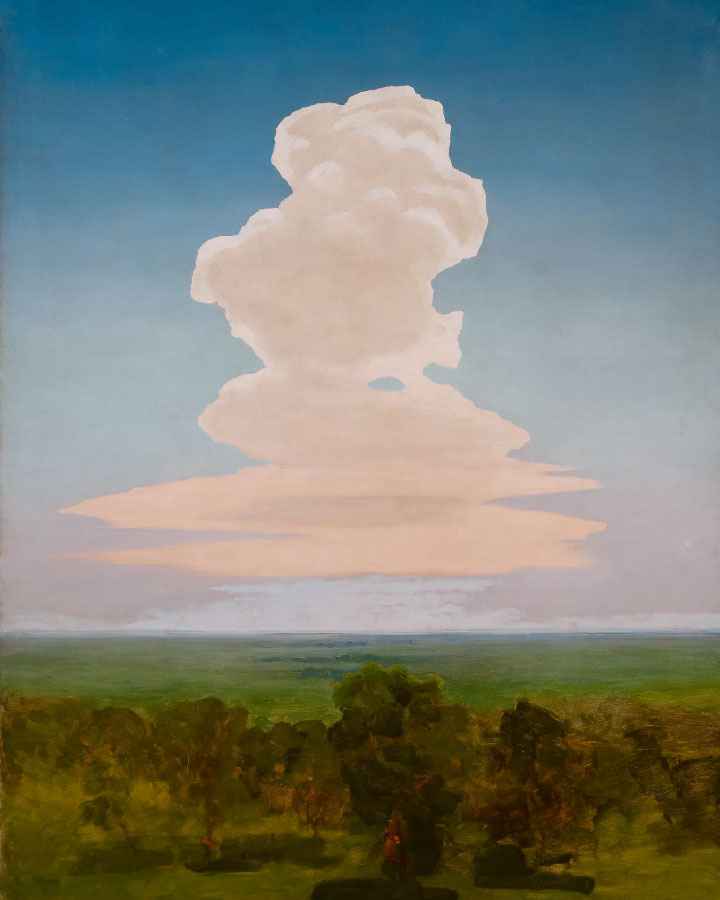
Clouds. 1900-1905
Unfinished. Oil on canvas. 194 × 140 cm. Russian Museum
The Tretyakov Gallery's previous Kuindzhi exhibition was held nearly a quarter of a century ago, in 1992, and featured a portion of the great artist's legacy, mostly his finished pieces. The current show, along with such well-known compositions, introduces numerous sketches and drafts created during the period of Kuindzhi's self-imposed isolation from 1882 up to his death in 1910, during which time the artist was, for the effective purposes of the outside world, not painting. The latter pieces were first introduced to the public at the artist's posthumous exhibitions organized by the “Kuindzhi Society" in 1913-1914 in St. Petersburg and Moscow. The wealth of the artist's sketches and drafts was re-introduced to the public only many decades later, when in 2007 the Russian Museum organized a Kuindzhi exhibition based on its own rich reserves.
The Tretyakov Gallery has considerably expanded the range of its new Kuindzhi show, which includes about 200 pieces drawn from 23 museums from Moscow, St. Petersburg and other regions of Russia, as well as the former Soviet Republics of Azerbaijan and Belarus, and from private collections.
Occupying two storeys of the museum's Lavrushinsky Engineering Wing, the show is divided into four sections, each focusing on a separate theme: “The Gravity of the Earth", “The Mystery of the Night", “Amidst the Vastness of Eternity", and “Ahead of Time". It is accompanied by a detailed chronicle of Kuindzhi's life and artistic career, illustrated with photographs and documents, and also enhanced with a multimedia component compiled by the Tretyakov Gallery's technology department from Kuindzhi's artwork, and an animation film focusing on the painter's inner world.
Kuindzhi's life remains rich in secrets and legends, and even the precise date of his birth is unknown. The Russian State Historical Archive in St. Petersburg holds three of the artist's passports, each with a different year of birth - 1841, 1842 and 1843 - although the most likely date seems to be 1842.
The artist neither wrote a diary nor exchanged letters with his contemporaries, so his archive is distinctly slim, including only a few letters to Pavel Tretyakov and to various officials. Very possibly that was because of his poor literary grounding: Kuindzhi received nothing in the way of a systemic academic education.

A Birch Grove. 1879
Sketch version of the painting with the same title (1879, Tretyakov Gallery)
Oil on paper mounted on cardboard. 21 × 33.5 cm. Russian Museum
Arkhip Ivanovich Kuindzhi was born into the family of a Russianized Greek, Ivan Khristoforovich Emendzhi, a shoemaker and grower of grain, in Karasevka, a Tatar neighbourhood on the outskirts of Mariupol in present day Ukraine. In the late 18th century, pursuant to Catherine Il's edict, many Crimean Greeks moved to the north coast of the Sea of Azov, over time becoming assimilated into the local Tatar population.
The fourth and last child of the family, Kuindzhi was orphaned at an early age and raised first by his father's sister, and then by his elder brother Spiridon and his wife. From his early days onwards the boy had to do a range of demanding jobs, including looking after animals, keeping records of brick use at the construction site of a Catholic church (under “subcontractor Chabanenko’’), and working for “Amoretti", a grain merchant. The future artist finished only a parish school two-year curriculum, and continued to educate himself throughout his life. In 1868, perhaps heeding advice from Ivan Aivazovsky, in whose private studio he had studied, Kuindzhi became a non-matriculated student at the Imperial Academy of Fine Arts in St. Petersburg. In 1878, he was granted the title of first-degree artist, although he never took exams in any academic disciplines.
The artist possessed a fierce Oriental temperament that was especially noticeable in arguments, and apparent in his faculty for expressing his opinion and the determination with which he pursued his goals. In all the fields in which Kuindzhi involved himself - whether art, teaching or trade - he always enjoyed impressive success.
The artist's friends praised his moral virtues. He valued friendship and had a capacity for compassion, helping people when needed, and taking care of his students. He and his spouse Vera Leontievna lived a quiet, isolated and modest life. In addition to painting, he was especially keen on music. Literally in awe of nature, he was afraid of trampling the grass underfoot or accidentally stepping on a beetle or an ant. He was especially fond of birds: “People kept bringing him doves and sparrows wounded from a slingshot or simply sick; he and his wife would bandage and heal them," his student Arkady Rylov recalled.[1]
The artist saw God in every living creature: he had a mystical, religious bent of mind and a pantheist view of the world. He used to call himself a religious person, saying “that the primordial energy fills the world throughout".[2]
Kuindzhi's friends and students recalled his interest in philosophy, and unlike many of his contemporaries he remained immune to the appeal of naturalism and positivism. As one of his followers put it, “in his compositions we aren't going to find those ‘People's Will'-like ideas[3] that held the intelligentsia in thrall then. And yet, in his heart, Kuindzhi was more revolutionary-minded than many of the Peredvizhniki artists."[4] The artist had a reputation as a diehard monarchist, one who was nonetheless never afraid of speaking out against bureaucracy, formalism and legalism.
Kuindzhi's views shared something in common with the philosophical outlook of prominent figures of the Russian religious revival of his time. Some of the artist's public pronouncements and, most importantly, his public conduct suggest that he was familiar with Nikolai Fyodorov's philosophy of humankind's “Common Task". The thinker's Christian ideal of “living with everyone and for everyone", as well as his appeal to cherish even the weakest manifestations of a person's individuality, as something that can be brought to perfection in practically every human being as a result ofjoint creative efforts, guided the great artist in his teaching.[5] Fyodorov famously regarded education as an idea of brotherhood in action and an undertaking that required concentrated, almost family-style cooperation. According to the accounts of his contemporaries, Kuindzhi's workshop had the semblance of a family too, where all involved were tied together by strong spiritual and artistic bonds.
Almost always together, the “Kuindzhists" worked side by side, debating important questions, organizing music evenings; in summer, they would visit Crimea, where the artist owned a large plot of land, to sketch. The teacher was wholeheartedly committed to his students and, in addition to professional skills and artistic knowledge, helped to cultivate in them the qualities he considered of paramount importance: camaraderie, the importance of mutual assistance, and a sense of responsibility for one another. It was no coincidence that Roerich called Kuindzhi “a guide in life and art".[6]
Roerich pointed to certain affinities in character and psychology between Kuindzhi and the philosopher-poet Vladimir Solovyov: “Kuindzhi in his private conversations comes across as a real intuitive philosopher. What fine constructive ideas were suggested by him; he obviously reacted nervously whenever a third party entered. As if something would disappear in that moment. The same thing, incidentally, would happen to Vladimir Solovyov, too. If there was an intrusion, the entire precious thread of the discourse would be instantly lost, and he would hurry to end the conversation."[7]
A sense of intonation is what most of all unites Kuindzhi's artwork and Solovyov's poetry, full as it is of otherworldly mysteries, “the pulsation of the life of the world", and the imagery of the Eternal “Virgin of the Rainbow Gate" - Sophia of the Wisdom of God. For Kuindzhi too, many of his compositions - “Moonlight Night on the Dnieper" (1880, Russian Museum), “A Birch Grove" (1879, Tretyakov Gallery), or “Clouds" (1900-1905, Russian Museum) with their mysterious mountain peaks and viscous hazy steppes, or “Rainbow", shining with a mystical light in the sky (1900-1905, Russian Museum) - sought to capture the cosmic, innermost sense of nature.
The core of Solovyov's philosophical system is the principle of “Total Unity", expressed in the idea of the synthesis of science and religion, thought and experience, physics and metaphysics, humankind and God. This doctrine, developed in the works of Solovyov's followers - the acclaimed Russian religious thinkers Sergei Bulgakov, Yevgeny Trubetskoy and Pavel Florensky - formed the foundation of the methodology of the philosophy of Russian Cosmism. Kuindzhi demonstrated the ability to capture the effect of soaring in the air, a sense of altitude and of the earth's cosmic colours in his artwork, especially in his late pieces. Thus it was only natural that he, together with his students Bogaevsky, Borisov and Roerich, have been seen by researchers of Russian Cosmism as exponents of that movement.[8]
The Tretyakov Gallery exhibition highlights the wide range of the artist's thematic interests, as well as his “skyward drive" in the depiction of the vast expanses of the earth to the breadth of the sky.
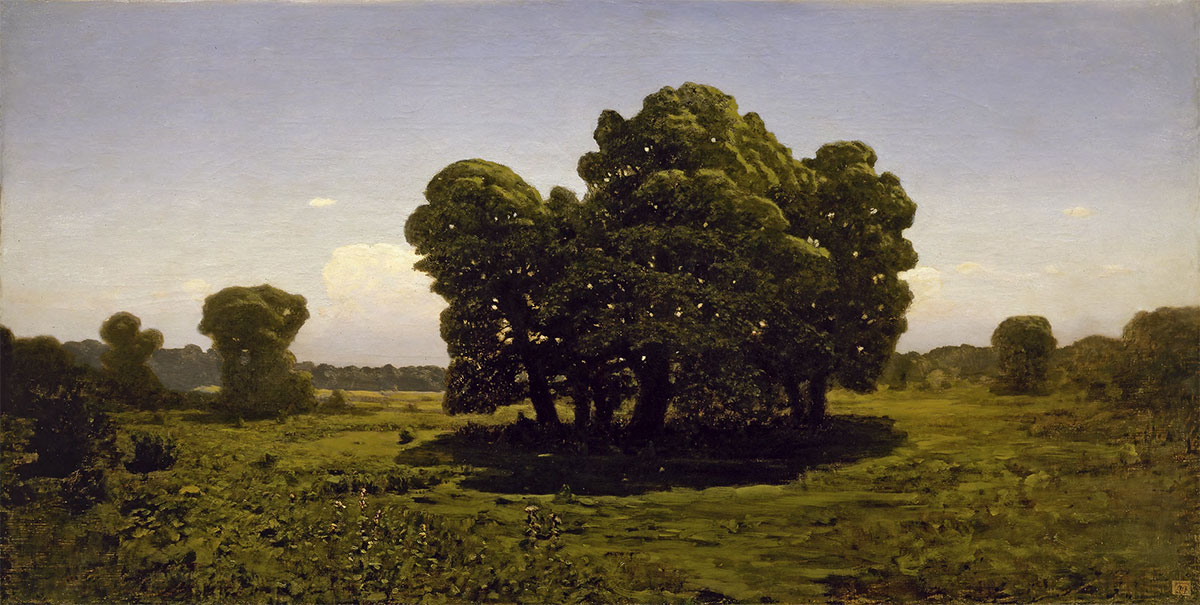
Oaks. 1900-1905
Oil on canvas. 83 × 164 cm. Russian Museum
The section “The Gravity of the Earth" features Kuindzhi's major compositions that brought him fame after their display at various academic exhibitions and at the “Peredvizhniki" (Wanderers) shows, as well as sketches and drafts for such work. The compositions that Kuindzhi created late in his life, such as “Oaks" and “Crimea" (both 1900-1905, Russian Museum), are an exception. United by the section's theme, the pictures represent a view from a high point of vantage, with the painter's eyes directed towards the earth, to the things that draw his attention.

Crimea. 1900-1905
Unfinished. Oil on canvas. 140 × 210 cm. Russian Museum
The landscapes feature different styles: from the academic (“Lake Ladoga", 1871, Russian Museum) and the realist (“On the Island of Valaam", 1873), to the plein air and impressionist (“The North", 1879), with elements of Art Nouveau and Symbolism (“A Birch Grove", “After Rain", both 1879 and now at the Tretyakov Gallery; “Crimea").
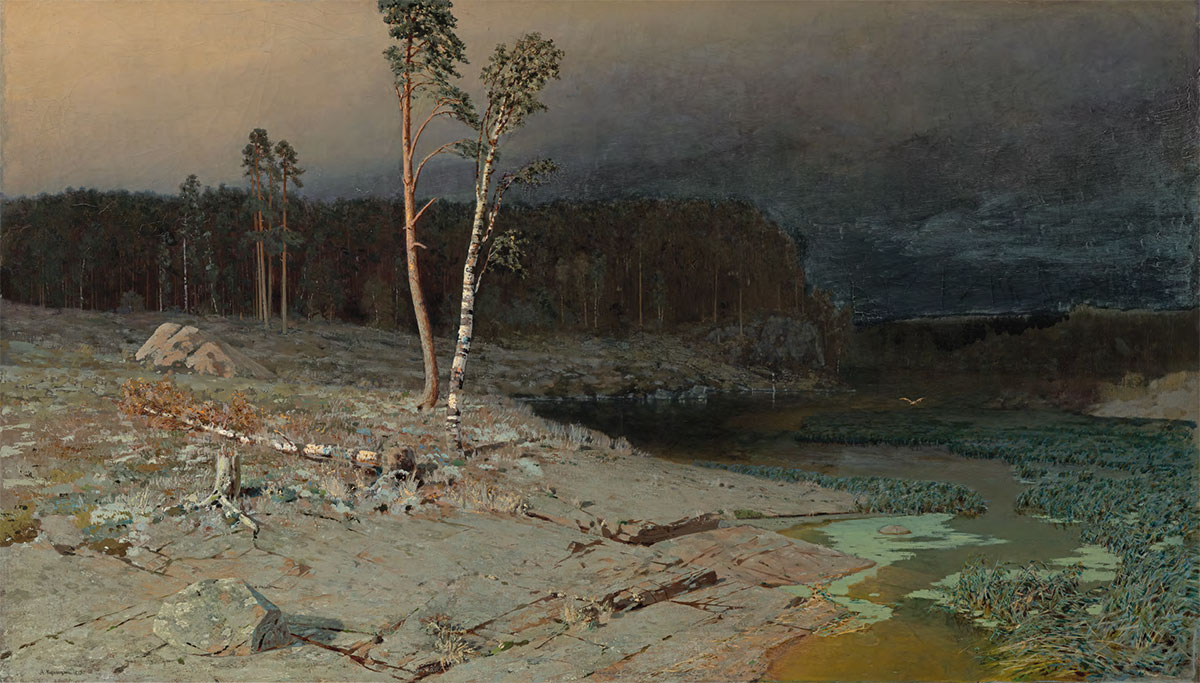
On the Island of Valaam. 1873
Oil on canvas. 79.5 × 131.6 cm. Tretyakov Gallery
The artist pursued different artistic goals in these works. In “Lake Ladoga", he sought to capture the limpid water of the lake and reveal its rocky lower depths, while in the celebrated “A Birch Grove" the task was to convey the illusion of a dazzling sunlight that is actually itself missing from the picture; in “Oaks", it was to convey the planetary might of the centuries-old trees. Though diverse in painterly technique these works reveal a synthesized and deeply memorable image of nature.
The artist was able to tackle a difficult painterly challenge by using innovative techniques: he boldly fragmented the composition, aptly matched colours, varied the texture of colour patches, and used the rich potential of colour spots and undercoat.
The section “Mysteries of the Night" introduces compositions that convey the effects of nocturnal illumination - from bright flashes in the sunset sky, through their smooth fading at dusk, to the bewitching colours of night. In an era dominated by positivism, the artist was eager to reveal in such images the mysterious character of the Universe or convey the excitement of someone feeling “at one" with nature in the late evening and through the night. The elements he used in this artistic endeavour were the motifs of moonlight, the shining of the stars, and sunsets. To address these artistic challenges he needed to use painterly techniques that were unusual for the time - he used a colour scheme that really only gained currency in the art of the early 20th century.
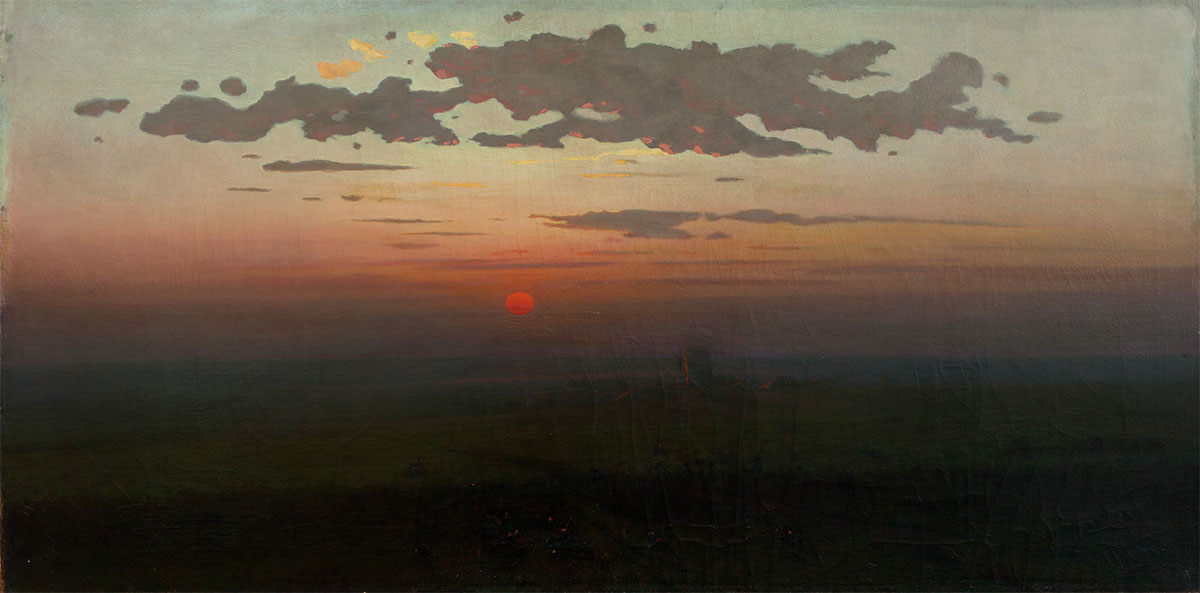
Sunset on the Steppes. 1900
Oil on canvas. 83 × 146 cm. National Museum of the Republic of Buryatia, Ulan-Ude
“Sunset on the Steppes" (1900, National Museum of the Republic of Buryatia, Ulan-Ude) is displayed in Moscow for the first time, shown together with its preparatory sketches, as well as Kuindzhi's sketches for the large composition “Red Sunset" (1900-1905, Metropolitan Museum of Art, New York). Eager to achieve a high degree of expressiveness, the artist, in his preparatory sketches comes very close to an expressionist style.
The nocturnal landscapes on display are marked by their innovative approaches. Emulating the dark of the night in the “Ukrainian Night" (1876, Tretyakov Gallery), the artist deliberately eschewed depicting objects in the foreground - instead, he sketched out the wide band of the horizon in saturated blue. The deep cobalt-like colour of the earth and the sky, with small grey areas of undercoat sometimes peeking through, serves to create the contrast between the pale green footpath and the white wattle and daub huts, so that they give off a glow, as happens in moonlight in real life. Although the moon is missing from the picture, the achieved effect suggests its presence.
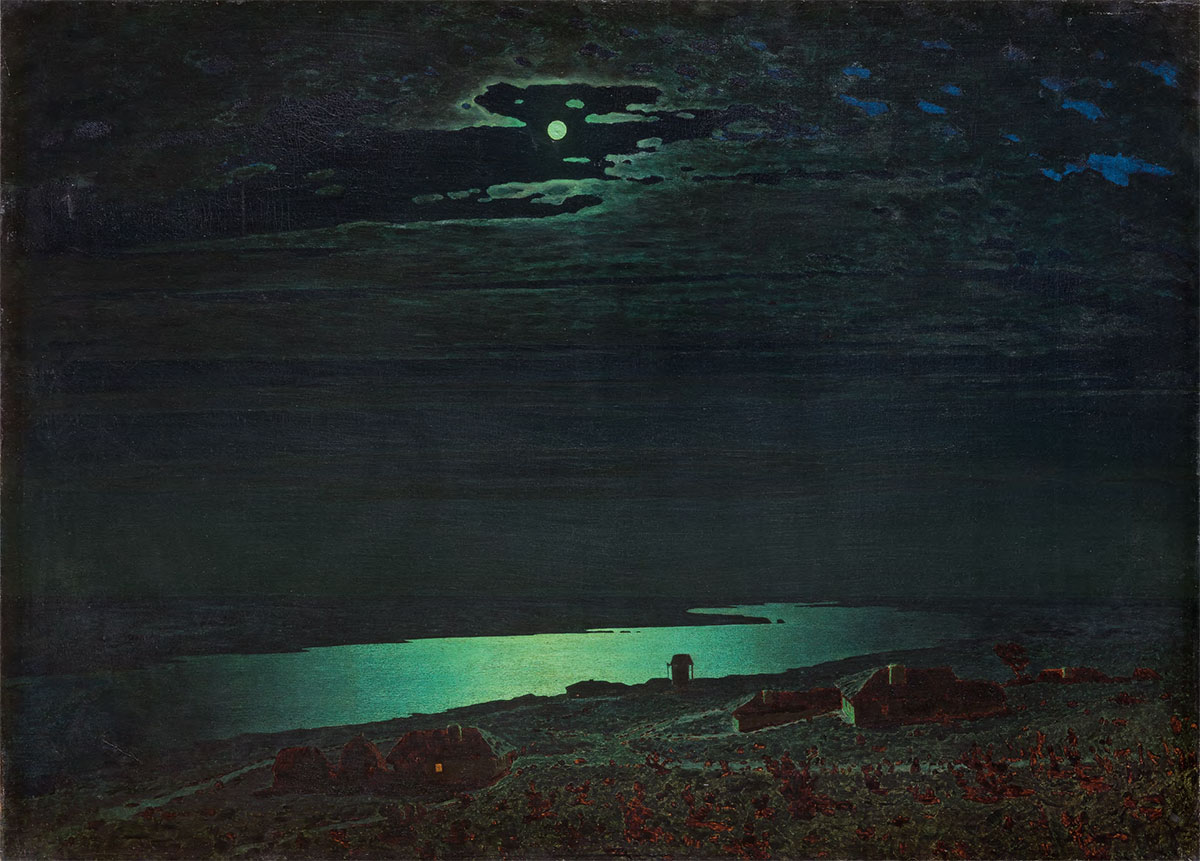
Night on the Dnieper. 1882
Replica of “Moonlight Night on the Dnieper” (1880, Russian Museum)
Oil on canvas. 104 × 143 cm. Tretyakov Gallery
Kuindzhi's aptitude for revealing nature's innermost essence is most fully realized in “Moonlight Night on the Dnieper" (1880, Russian Museum), in which the mystical light from the moon pictured in the composition turns the natural setting into a space of dream and magic, one that enthralls and hypnotizes the viewer. It was one of the last pictures that the artist showed publicly: after leaving the “Peredvizhniki" group, Kuindzhi began to handle issues related to his solo exhibitions himself, and designed ideal circumstances for displaying “Moonlight Night". It was hung, a single work in a dark room, with a beam of electric light shone on it. Such directed lighting not only served to create a heightened emotional charge but fulfilled another equally important goal, too. Kuindzhi was well aware of the inner mechanics of visual perception relating to reflected and absorbed light in painting, and knew how to use this knowledge in practical terms: thus the areas with light-coloured thick, textured paints (the moon, the path of moonlight on the water, the windows of the huts) reflected the light more strongly than the similar light-coloured spots on a smooth surface. In the light of a lamp, the light-coloured textured spots become even lighter, while also acquiring a glow; the ripples of the path of moonlight on the water, scratched with a dry brush, play a similar role. The different levels of intensity in the highlights on the picture's elevated and depressed areas enhance the glimmering effect while also creating the illusion of weak ripples on the smooth water. The dark spots of the sky and the earth absorb the artificial light, thus enhancing the richness of colour and augmenting the velvety feel of the painting.
This technique, involving the usage of the optical properties of juxtaposed colours, contributed considerably to the resulting effect of “real" lighting. It meant that certain colours, such as blue and yellow, when juxtaposed were bound to enhance each other's intensity and create a sense of depth, while minute dark dabs on illuminated spots convey a sense of vibration of light. The foreground of the painting, typically treated only sketchily, does not attract the viewer's attention, while, by contrast, the carefully crafted sky becomes the conceptual centre of the composition. The majestic, solemn spectacle mightily presented on the canvas leads the viewer to reflect on eternity and the enduring beauty of the world, because “both the dark of the night and the night moonlight are a visual expression of the awesome and terrifying mystery of the world".[9]
Ilya Repin recalled the atmosphere at the Society for Encouragement of the Arts on Bolshaya Morskaya Street in St. Petersburg, where the show was held: “People formed a long queue on the stairs waiting to be admitted, as well as along the street, on both sides of the pavement; crowds stood waiting patiently, hour after hour, stringently maintaining order as they approached the much-coveted door through which people were ushered only one group at a time, lest the visitors suffocate on account of the shortage of space and air..."[10] According to Repin's account, people would stand in front of Kuindzhi's picture “in prayerful silence" and leave the room in tears.
The painting was bought by Prince Konstantin Konstantinovich, and occupied a permanent place in his dwelling. Two other replicas of the painting remained in the artist's studio until his death, and were acquired only decades later by museums (one, by the Tretyakov Gallery, the second by Simferopol Art Museum). The three works are exhibited together at the show.
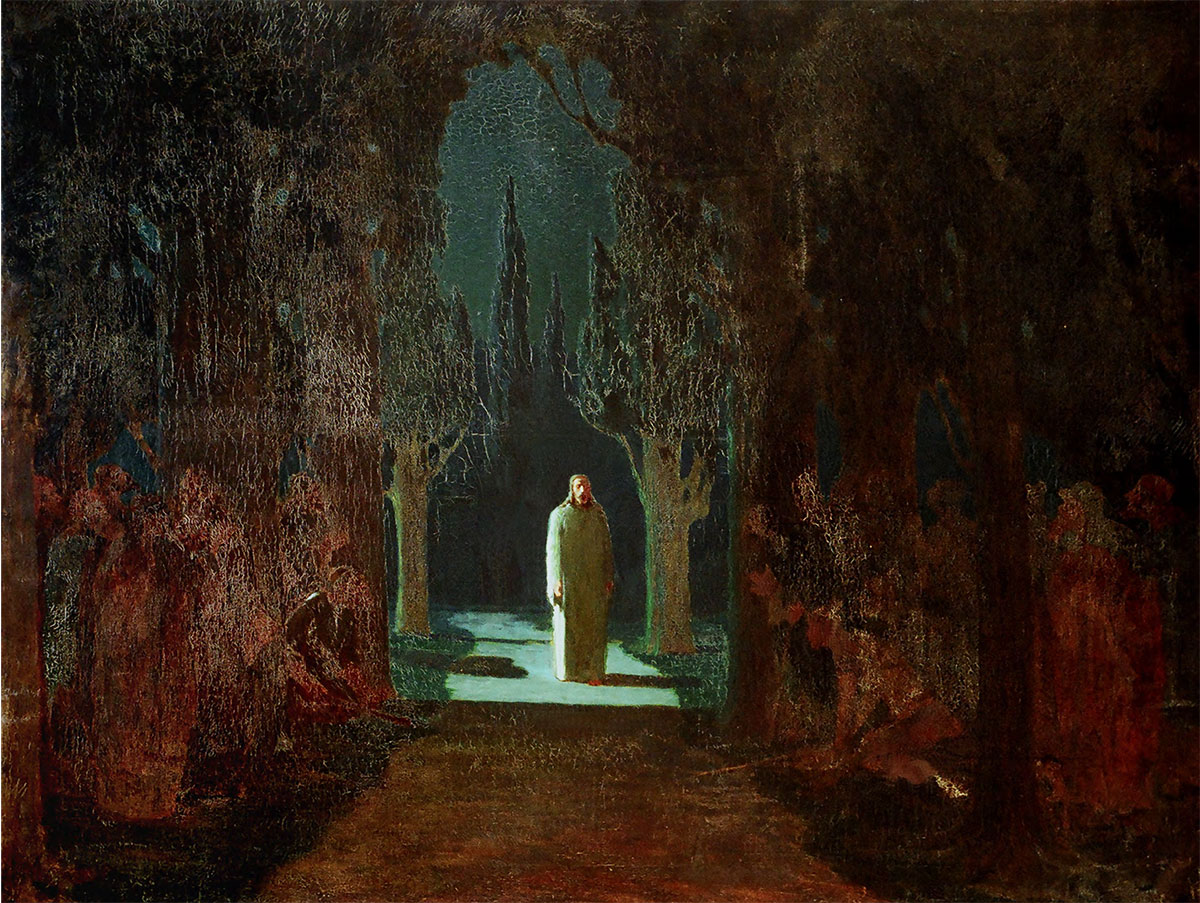
Christ in the Garden of Gethsemane. 1901
Oil on canvas. 106.5 × 142.5 cm. Alupka Palace and Park Museum-Reserve
The theme of light was brought to a logical conclusion in “Christ in the Garden of Gethsemane’’ (1901, Alupka Palace and Park Museum-Reserve), in which Kuindzhi attempted to depict the metaphysical light, beautiful beyond belief, that came neither from the sun nor the moon, but from the figure of the Saviour. The picture's narrative evokes the Gospel, the rites of the holy liturgy, and the writings of the Church Fathers.
The section “Amidst the Vastness of Eternity" features works that Kuindzhi created over the 30-year-long period of his self-imposed isolation; they never left his studio during the artist's lifetime.
Kuindzhi preferred living on the upper floors of the buildings of St. Petersburg, in residences with large windows and a direct staircase from the apartment to the roof; he would go up there, to feed the birds and enjoy the views the position afforded, on a daily basis.
Nearly all of Kuindzhi's works are created from a bird's-eye perspective, as if the artist himself, overcoming the forces of gravity, has ascended into the sky, to mentally grasp the immensity of the world from above. There are even apocryphal legends that the artist was designing a flying machine, cherishing the hope that he might ascend into the heavens. In reality, it was the artist's unique imagination that enabled him to convey on canvas the effect of soaring up in the air, and the sense of altitude and of the Earth's cosmic might.
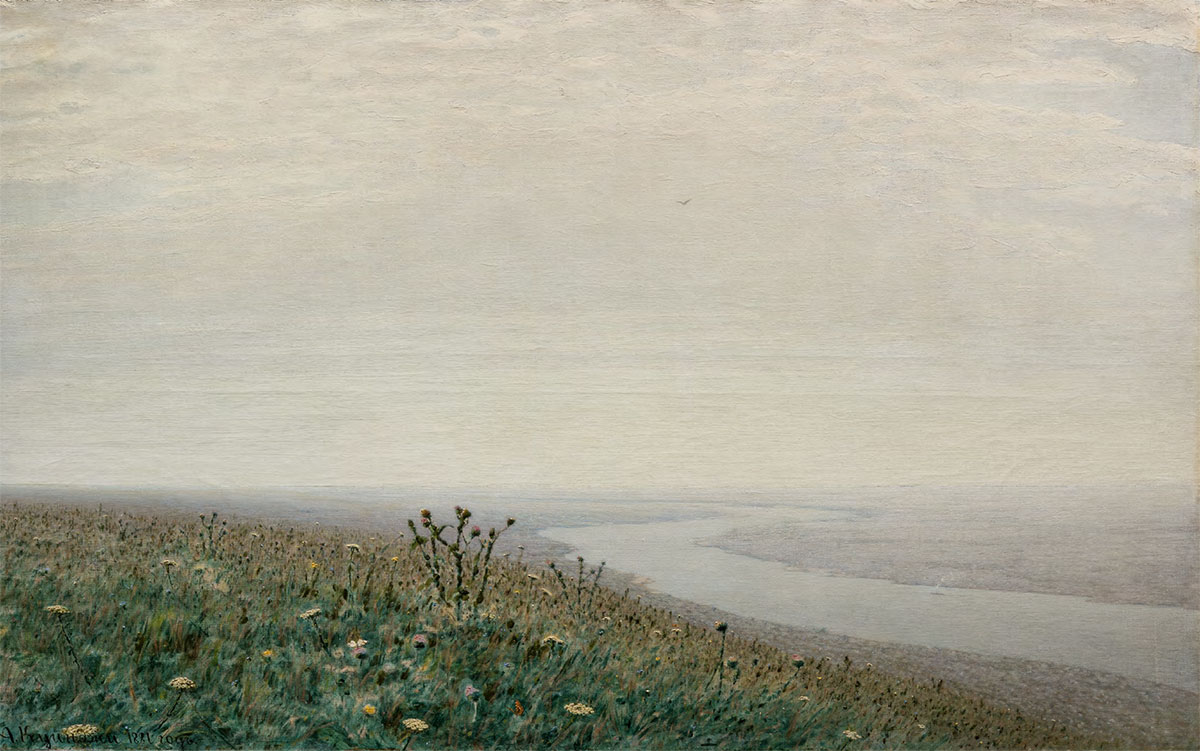
Morning on the Dnieper. 1881
Oil on canvas. 107.5 × 170.5 cm. Tretyakov Gallery
Such keen open spaces also come to life in his images of the steppe, the sea and of mountain landscapes. In his depictions of the first, the artist developed an interest in painting space as one of the forms of the universe, and pictures such as “Morning on the Dnieper" (1881, Tretyakov Gallery), “The Dnieper" (1901, Pskov Open-Air Reserve of History, Architecture and Art), and “The Volga River" (1905-1908, National Art Museum of Azerbaijan, Baku) demonstrate how, using shape and colour economically, he was attempting to convey one of the categories of space - the majesty of the void.
During the time he spent at his home in Crimea, the artist often depicted the boundless expanses of the sea, capturing through his brushwork the impetuous, variegated run of the waves, and translating the living and breathing forms of nature into the visual language of Art Nouveau and Symbolism. Among such compositions, “Mist at Sea" (1900-1905, Russian Museum) is especially noteworthy: the artist's first biographer Mikhail Nevedomsky wrote emphatically, “This wide and slow surf on the beach, stylized with straight lines, formed by the foam sent by the sea from its infinity, as well as this measureless mass of water and the vastness of the sky over it - all that can be seen through the mist... produces a strong and altogether singular impression. And nothing so much as the word cosmic is fitting to characterize the holistic impression of the painting."[11]
In his mountain landscapes, Kuindzhi was preoccupied as before with the imagery of space and the coldness of moonlight - those features that were most likely to turn the view into a poetic metaphor of the mysterious Universe. It was likely that the famous scientist Dmitry Mendeleev knew about Kuindzhi's aspiration to “capture" the world from the cosmos when, in 1887, he went up in a hot air balloon. He wrote about the experience in an account of the flight: “Above and below the clouds [the views] are singular and worthy of Kuindzhi's brush, but I have no gift for entertaining description, so I describe not what I felt nor what disposed me but what I did, what I thought, and how I thought it over."[12]
Kuindzhi's sense of innovation can be seen in each section of the exhibition, but some works, somehow focusing on a different set of themes, are displayed separately in the section “Ahead of Time". A series of winter landscapes created at different periods is especially noteworthy, its compositions demonstrating how closely the artist had studied the experience of the Impressionists, interpreting it, of course, in his own way.
Like the French artists, Kuindzhi was interested in how the air around an object changed its local colour. Further to this, he had a serious interest in the results of scientific research in the field of paints and painting technologies - his curiosity boosted by his friendship with the scientists Dmitry Mendeleev and Fyodor Petrushevsky. Kuindzhi's key visual effects - his brightness of colours and decorative quality, the illusion of depth of space and stereoscopic vision - were based on the system of complementary colours and Petrushevsky's discoveries in the use of colour depicting light. “His [Kuindzhi's] role in this respect," the art historian Vitaly Manin wrote, “was akin to the French divisionists, who drew, as he had, only a little later, on scientific discoveries."[13] Nevedomsky also noted that Kuindzhi in his conversations with students sometimes “would go into detailed analysis, quoting the formulae of physics, testing lighting effects, and presenting data referring to the laws of reflection..."[14]

The Effect of Sunset. 1900s
Oil on paper mounted on canvas. 39 × 53 cm. Russian Museum
Kuindzhi had a remarkable ability to achieve the illusion of transformation of ordinary paints into light. Painting similar landscape compositions at different times of the day, he created spectacular lighting effects in works such as “Sun Spots on Frost" (1876-1890), “The Effect of Sunset" (1900) and “Spots of Moonlight in a Forest. Winter" (1900, all at the Russian Museum), and in doing so moved closer to Symbolism and the Art Nouveau.
Through such empirical methods, Kuindzhi developed a theory of colour tones and light intensity in painting, on the basis of which Nikolai Krymov would later formulate his own theory; it is evident in works by Kuindzhi such as “A Forest Glade. Fog" (1890s), “Sun in the Forest" (1900) and “A Grove" (1900s) (all at the Russian Museum).

Autumn. 1890-1895
Oil on paper mounted on canvas. 36.8 × 58.7 cm. Russian Museum
Kuindzhi's “Autumn" (1890-1895, Russian Museum) is featured in this section. It seems to allude to his “A Birch Grove" (1879, Tretyakov Gallery), compellingly showing that the artist was gravitating towards an element of decorativeness.
Kuindzhi was not afraid to experiment: he traced out the trunks and crowns of trees in an applique manner, sketchily rendered architectural structures, and depicted the small wattle and daub huts with horses and cattle wandering nearby in a primitive, childlike manner, thus paving a path towards the art of the 20th century. Placing him among the very greatest figures in art, those of true genius, Repin rightly called Kuindzhi “an artist of unparallelled originality".
- Rylov, Arkady. “Memoirs”. Moscow, 1954. P. 70.
- Kuindzhi’s statement is quoted from: Nevedomsky, M.P.; Repin, I.E. “Arkhip Kuindzhi”. Moscow, 1997. P. 288. Hereinafter - Nevedomsky.
- “People’s Will”, or Narodnaya Volya, was a revolutionary political organization in the Russian Empire which appeared at the end of the 1870s. Advocating the assassination of government officials as part of an attempt to promote reforms, it consisted of loosely linked underground cells: it was responsible for the assassination of Tsar Alexander II in March 1881.
- Kurilko, Mikhail. ‘Conversation about Kuindzhi’ // “Khudozhnik” (Artist). 1980. No. 12. P. 61.
- Kuindzhi’s familiarity with Fyodorov’s philosophy can be inferred from the fact that many of the thinker’s ideas were also realized in the artist’s treatment of his students, among them this tenet: “Only the teaching about kinship solves the question about the crowd and the individual: unity does not devour but magnifies every single individual, while differences between individuals only strengthen the unity.” (Fyodorov, Nikolai. “The Philosophy of the Common Task”, 2 vols. Vol. I. Moscow, 2003. P. 41).
- Roerich, N.K. (Nicholas). “Fragments of the Literary Legacy”. Edited by Kuzmina, M.T. Moscow, 1974. P. 86.
- Roerich, N.K. (Nicholas). “Pages of a Diary”. In 3 vols. Vol 3. Moscow, 1995. P. 106.
- Trofimova, E.A. “Cosmism in Russian Culture of the Silver Age”. Habitation thesis. St. Petersburg, 2015.
- Trubetskoi, Ye.N. “The Meaning of Life”. P. 123.
- Repin, Ilya. Far and Near. Moscow, 1961. P.332.
- Nevedomsky. P. 307.
- Quoted from: Mendeleev, A.I. ‘Memories of the Past Long Gone’ // “Repin: Articles and Documents”. In 2 vols. Edited by Grabar, I.E.; Zil- bershtein, I.S. Vol. 2. Moscow-Len- ingrad, 1949. P. 182.
- Manin, V.S. “Kuindzhi”. Moscow, 1976. P. 79.
- Nevedomsky. P. 218.
Oil on canvas. Tretyakov Gallery. Detail
Oil on cardboard mounted on canvas. 36 × 55 cm. Samara Regional Art Museum
Oil on canvas. 110 × 71.5 cm. “Museum of Regional History and Art” Association, Tula
Oil on canvas. 132 × 103 cm. Tretyakov Gallery
Oil on canvas. 79.5 × 62.5 cm. Russian Museum
Oil on paper mounted on canvas. 53 × 39 cm. Russian Museum
Oil on paper mounted on canvas. 55 × 36.5 cm. Russian Museum
Oil on canvas. 165.5 × 115 cm. National Art Museum of the Republic of Belarus, Minsk
Oil on paper mounted on canvas. 39 × 53 cm. Chuvash Art Museum, Cheboksary
Oil on paper mounted on cardboard. 17.4 × 10.8 cm. National Art Museum of the Republic of Belarus, Minsk
Sketch of the painting with the same title (1900-1905, Russian Museum). Oil on paper mounted on cardboard. 11.4 × 17.4 cm. Russian Museum
Oil on paper mounted on cardboard. 17.3 × 10.9 cm. Russian Museum
Sketch of “Crimea” (1900-1905, Russian Museum). Oil on paper mounted on canvas. 38 × 56.3 cm. Radishchev Art Museum, Saratov
Oil on canvas. 46 × 36 cm. Nizhny Novgorod Art Museum
Oil on canvas. 102 × 159 cm. Tretyakov Gallery
Oil on paper mounted on cardboard. 11 × 17.3 cm. Russian Museum
Oil on paper mounted on cardboard. 11 × 17 cm. Russian Museum
Oil on paper mounted on cardboard. 11.3 × 17.7 cm. Russian Museum
Sketch for “Rainbow” (1900-1905, Russian Museum). Oil on canvas. 25 × 31.2 cm. Museum of Fine Arts of the Republic of Tatarstan, Kazan
Oil on canvas. 110 × 171 cm. Russian Museum
Oil on canvas. 81 × 163 cm. Russian Museum
Oil on paper mounted on cardboard. 10.7 × 18.1 cm. Russian Museum
Oil on paper mounted on canvas. 34.5 × 60.6 cm. Russian Museum
Oil on paper mounted on canvas. 39 × 52.5 cm. Russian Museum
Oil on paper. 10.8 × 17.3 cm. Russian Museum
Oil on canvas. 107 × 169 cm. Russian Museum
Oil on paper mounted on cardboard. 32 × 20.3 cm. Russian Museum
Oil on paper mounted on cardboard. 16.8 × 33.5 cm. Russian Museum
Oil on paper mounted on canvas. 40.5 × 58 cm. Russian Museum
Oil on oilcloth mounted on cardboard. 25 × 30.2 cm. Russian Museum
Oil on cardboard. 19.5 × 24 cm. Tretyakov Gallery
Oil on oilcloth mounted on cardboard. 30 × 19.3 cm. Russian Museum
Oil on paper mounted on cardboard. 10.9 × 17.2 cm. Russian Museum
Oil on canvas. 25.6 × 40.2 cm. Russian Museum
Oil on canvas. 104.5 × 169 cm. National Art Museum of Azerbaijan, Baku
Oil on paper mounted on cardboard. 25 × 30.6 cm. Penza Savitsky Art Gallery
Oil on paper. 10.9 × 17.3 cm. Russian Museum
Unfinished. Oil on canvas. 140.4 × 177.5 cm. National Art Museum of the Republic of Belarus, Minsk
Oil on paper. 20.8 × 24.8 cm. Russian Museum
Oil on paper mounted on cardboard. 11.5 × 17.5 cm. Penza Savitsky Art Gallery
Oil on canvas. 40.5 × 55 cm. Kursk Deineka Picture Gallery
Oil on paper mounted on cardboard. 30.5 × 25 cm. Russian Museum
Oil on paper mounted on cardboard. 11 × 17.8 cm. Russian Museum
Oil on paper mounted on cardboard. 18 × 11.5 cm. Russian Museum
Oil on canvas. 24.3 × 25 cm. Russian Museum
Oil on canvas mounted on cardboard. 40 × 25 cm. Russian Museum
Oil on canvas. 25 × 40 cm. Russian Museum
Oil on paper mounted on canvas. 40.5 × 53.5 cm. Russian Museum
Oil on oilcloth. 24.4 × 27.2 cm. Russian Museum
Oil on paper mounted on cardboard. 11 × 17.3 cm. Russian Museum
Oil on paper mounted on cardboard. 23.5 × 37.5 cm. Russian Museum




























































